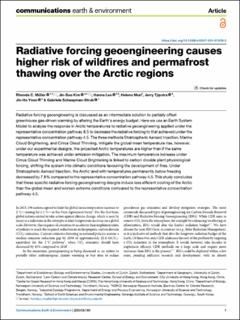| dc.contributor.author | Müller, Rhonda C. | |
| dc.contributor.author | Kim, Jin-Soo | |
| dc.contributor.author | Lee, Hanna | |
| dc.contributor.author | Muri, Helene | |
| dc.contributor.author | Tjiputra, Jerry | |
| dc.contributor.author | Yoon, Jin-Ho | |
| dc.contributor.author | Schaepman-Strub, Gabriela | |
| dc.date.accessioned | 2024-04-11T11:09:47Z | |
| dc.date.available | 2024-04-11T11:09:47Z | |
| dc.date.created | 2024-04-09T11:30:36Z | |
| dc.date.issued | 2024 | |
| dc.identifier.issn | 2662-4435 | |
| dc.identifier.uri | https://hdl.handle.net/11250/3126057 | |
| dc.description.abstract | Radiative forcing geoengineering is discussed as an intermediate solution to partially offset greenhouse gas-driven warming by altering the Earth’s energy budget. Here we use an Earth System Model to analyse the response in Arctic temperatures to radiative geoengineering applied under the representative concentration pathway 8.5 to decrease the radiative forcing to that achieved under the representative concentration pathway 4.5. The three methods Stratospheric Aerosol Injection, Marine Cloud Brightening, and Cirrus Cloud Thinning, mitigate the global mean temperature rise, however, under our experimental designs, the projected Arctic temperatures are higher than if the same temperature was achieved under emission mitigation. The maximum temperature increase under Cirrus Cloud Thinning and Marine Cloud Brightening is linked to carbon dioxide plant physiological forcing, shifting the system into climatic conditions favouring the development of fires. Under Stratospheric Aerosol Injection, the Arctic land with temperatures permanently below freezing decreased by 7.8% compared to the representative concentration pathway 4.5. This study concludes that these specific radiative forcing geoengineering designs induce less efficient cooling of the Arctic than the global mean and worsen extreme conditions compared to the representative concentration pathway 4.5. | en_US |
| dc.language.iso | eng | en_US |
| dc.publisher | Springer Nature | en_US |
| dc.rights | Navngivelse 4.0 Internasjonal | * |
| dc.rights.uri | http://creativecommons.org/licenses/by/4.0/deed.no | * |
| dc.title | Radiative forcing geoengineering causes higher risk of wildfires and permafrost thawing over the Arctic regions | en_US |
| dc.title.alternative | Radiative forcing geoengineering causes higher risk of wildfires and permafrost thawing over the Arctic regions | en_US |
| dc.type | Journal article | en_US |
| dc.type | Peer reviewed | en_US |
| dc.description.version | publishedVersion | en_US |
| dc.source.volume | 5 | en_US |
| dc.source.journal | Communications Earth & Environment | en_US |
| dc.source.issue | 180 | en_US |
| dc.identifier.doi | 10.1038/s43247-024-01329-3 | |
| dc.identifier.cristin | 2260187 | |
| dc.relation.project | Sigma2: NS2345K | en_US |
| dc.relation.project | Sigma2: nn9182k | en_US |
| dc.relation.project | Sigma2: NS9033K | en_US |
| dc.relation.project | Sigma2: nn9448k | en_US |
| dc.relation.project | Norges forskningsråd: 229760 | en_US |
| dc.relation.project | Sigma2: NS9576K | en_US |
| cristin.ispublished | true | |
| cristin.fulltext | original | |
| cristin.qualitycode | 1 | |

